It joins an adrenaline-inducing roll call of clever platforms offering spectacular views.
1. Dachstein Stairway to Nothingness (Austria)
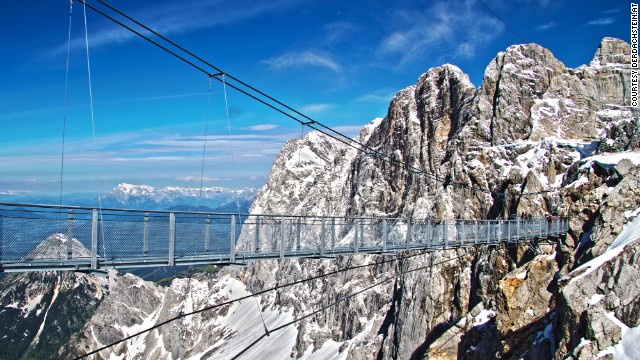 |
| Visitors to Dachstein's Stairway to Nothingness must first cross Austria's highest bridge, which is 328 feet (100 meters) long and straddles a drop of 1,300 feet (396 meters). Then they face 14 steps that descend from the cliff face and which are surrounded by glass walls. |
Visitors to Dachstein's Stairway to Nothingness must first cross Austria's highest bridge, which is 328 feet (100 meters) long and straddles a drop of 1,300 feet (396 meters).
They then face 14 steps that descend from the cliff face and which are surrounded by glass walls.
The entire structure took six months to build and was created by an engineering firm specializing in high-altitude construction.
The bridge that leads to the steps is the highest in Austria.
2. Tokyo Skytree observation decks (Japan)
 The Tokyo Skytree is the world's third-tallest structure, with a height of 2,080 feet (634 meters), and has Japan's two tallest observation decks: the lower one is located at 1,148 feet (350 meters) and has a section of glass flooring. The upper one, which has floor-to-ceiling windows and 360-degree-views of the city, has a height of 1476 feet (450 meters).
The Tokyo Skytree is the world's third-tallest structure, with a height of 2,080 feet (634 meters), and has Japan's two tallest observation decks: the lower one is located at 1,148 feet (350 meters) and has a section of glass flooring. The upper one, which has floor-to-ceiling windows and 360-degree-views of the city, has a height of 1476 feet (450 meters).On a clear day, Mount Fuji can be seen from the observation decks.
3. Kinzua Skywalk (United States)
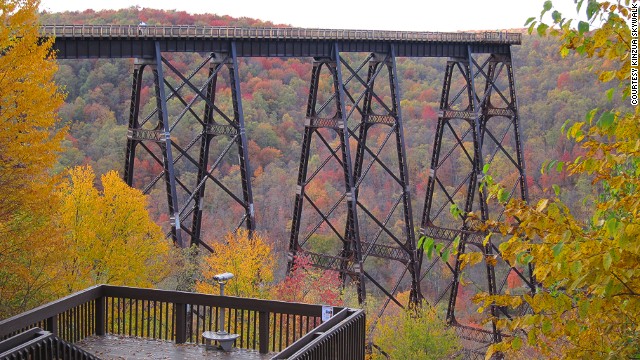
When the Kinzua Viaduct was built in Pennsylvania in 1882, it was the longest and highest viaduct in the world.
In 1900 it was rebuilt to carry heavier trains, using 3,175 tons of steel and 895,000 rivets.
In 2003, a tornado destroyed 11 of the 20 towers and it was decided that the remaining towers would be used to support the Skywalk.
The Skywalk extends 624 feet (190 meters) into the Kinzua Gorge and glass panels allow visitors to peer into the gorge below.
4. AlpspiX viewing platform (Germany)
 At the base of Germany's Alpspitze mountain, the AlpspiX viewing platform comprises two steel beams, both of which measure 79 feet (24 meters) in length.
At the base of Germany's Alpspitze mountain, the AlpspiX viewing platform comprises two steel beams, both of which measure 79 feet (24 meters) in length.Visitors brave enough to walk to the end of the glass-walled platforms can look 3,281 feet (1,000 meters) down into the valley.
The platform remains open in winter, when the grid flooring allows snow and ice to pass through.
5. EdgeWalk CN Tower (Canada)
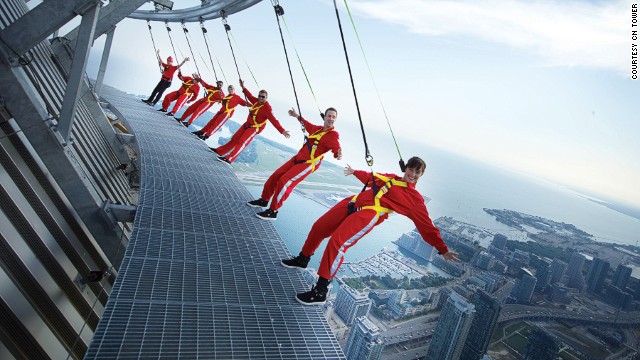 |
| Located on the roof of the CN Tower's restaurant at a height of 1,168 feet (356 meters), the EdgeWalk in Toronto allows visitors to slip into climbing harnesses and walk around the edge of Canada's tallest structure. There's also a glass floor 1,122 feet (342 meters) above ground level, and although this glass is only 2.5 inches thick, it's strong enough to hold 14 hippos -- if they could fit in the elevator. |
Located on the roof of the CN Tower's restaurant at a height of 1,168 feet (356 meters), the EdgeWalk allows visitors to slip into climbing harnesses and walk around the edge of Canada's tallest structure.
There's also a glass floor 1,122 feet (342 meters) above ground level, and although the glass is only 2.5 inches thick, it's reportedly strong enough to hold 14 hippos -- if they could fit in the elevator.
The EdgeWalk holds the world record for world's highest external walk attached to a building. CN Tower also has glass-floored observation deck and outdoor SkyTerrace.
6. The Ledge (United States)
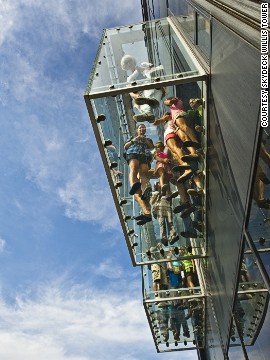 |
| Visitors who step into one of the Ledge boxes in Chicago can see for 50 miles across four states. Six million people have ventured into the boxes since 2009, 500 people have proposed in them and visitors can now even get married in them. |
The four boxes that make up The Ledge experience in Willis Tower, Chicago, are made from half-ton panels of glass. The walls consist of three layers, each half an inch thick.
Visitors who step into one of the boxes can see for 50 miles across four states.
Six million people have ventured into the boxes since 2009, 500 people have proposed in them and visitors can now even get married in them.
The boxes retract into the building when the windows need cleaning.
7. Cliffwalk (Canada)

The Cliffwalk is a 700-feet (213 meter) walkway attached to a granite cliff face above the Capilano River in British Columbia, Canada. The highest point is 300 feet (90 meters) above the river.
To attach the Cliffwalk, 16 anchor points were drilled 19 feet (six meters) into the rock face using 1,825 bolts, and 40 tons of steel were used.
The Cliffwalk also features two glass panels that have an anti-skid finish and were shipped over from Austria.
8. The View from The Shard (England)
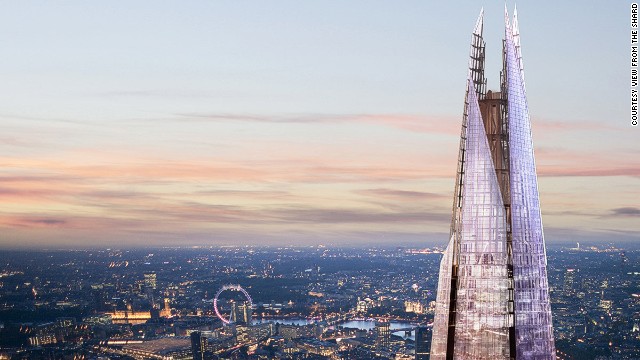
London's The Shard is the tallest building in Western Europe and The View From The Shard is located on floors 68, 69 and 72.
The best panoramas are from floor 72, at a height of 800 feet (244 meters).
This open-air observation deck offers 360-degree views of the city.
Visitors can also look up into the "shards" of glass that form the top of the skyscraper.
9. Stegastein lookout (Norway)

The glass panel at the end of this walkway gives visitors the impression they could simply fall off the end.
Commissioned by the Norwegian Highway Department as part of a project to improve the appearance of the country's tourist routes, the lookout allows visitors to look straight down into the Aurlandsfjord, 2,000 feet (609 meters) below.
10. Top of Tyrol Stubai Glacier (Austria)
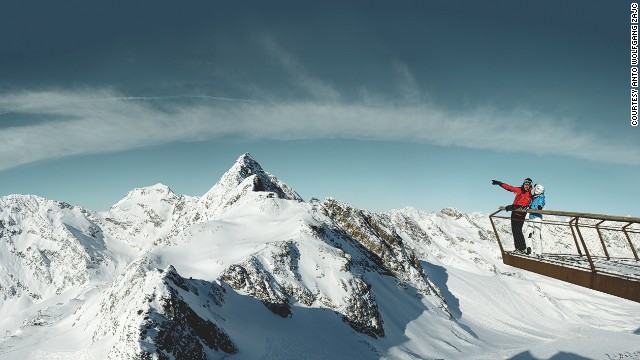
The Top of Tyrol viewing platform in Austria was completed in 2008 and provides visitors with spectacular views over 103 peaks.
All of the parts -- including 19 tons of steel and a 164-foot (50-meter) hand rail were lowered into place by helicopter.
It's 10,433 feet (3,180 meters) above sea level and 50-foot (15-meter) rock anchors keep the structure in place.
11. Dachstein Glacier Skywalk (Austria)
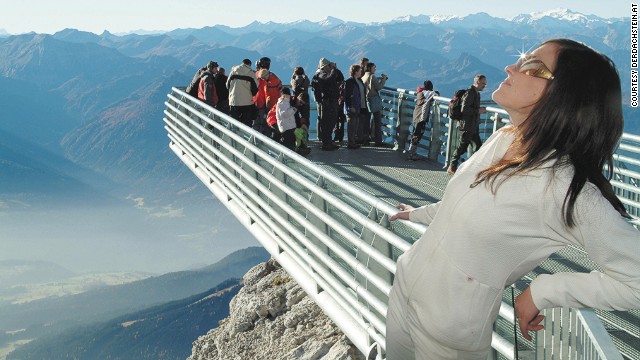
The Dachstein Glacier in Austria actually comprises eight glaciers -- a visit to this high-altitude, glass-bottomed walkway is a great way to see them all.
Visitors can see for hundreds of kilometers. On a clear day, the Triglav mountains of Slovenia and the forests of the Czech Republic can be seen.
12. Matteo Thun's Viewing Platform (Italy)

The best views of Italy's Merano region are from this binocular-shaped viewing platform, high above the gardens' huge oak forest.
The viewing platform is just one of several within the gardens, which were recently named Italy's most beautiful gardens.
The platform is suspended over the Gardens of Trauttmansdorff and was designed by architect Matteo Thun in 2005.
13. Grand Canyon Skywalk (United States)
This steel and glass, horseshoe-shaped walkway extends 70 feet (21 meters) over the lip of the Grand Canyon, almost one mile above the valley floor.
The 90 tons of glass were imported from Germany. The Skywalk, which is bolted to the canyon's rim, can support the weight of 70 747 passenger jets.
Apollo astronaut and the second person to set foot on the Moon, Buzz Aldrin was the first person to step onto the Skywalk, which cost $30 million to build.

No comments:
Post a Comment
whizqidconcept@gmail.com